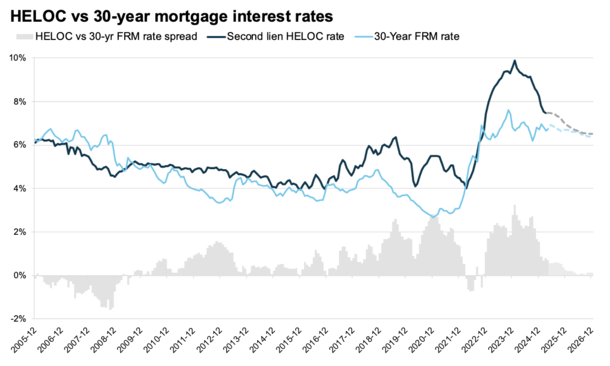US signals interest in using Fannie, Freddie to bolster budget
unitedbrokersinc_m7cmpd2025-06-03T14:22:51+00:00Signs are emerging that the Trump administration may be less willing to give up control of mortgage giants Fannie Mae and Freddie Mac than investors have bargained for, as policymakers scrounge for ways to close US budget gaps.In recent social media posts, Donald Trump said he's exploring the sale of new shares in the two companies, which play a key role in determining how much Americans pay for home loans — but he also made clear the government will keep a strong oversight role. READ MORE: What Trump's latest GSE comments could mean for mortgagesAnd in recent interviews, Federal Housing Finance Agency director William Pulte said the administration is considering a public offering without actually exiting conservatorship, the quasi-government ownership imposed on the two companies since a 2008 bailout. "Maybe there's a way to take these companies public and use these companies for what they are, which are assets for the American people," Pulte said Monday in an appearance on Fox Business. The comments suggest the administration could choose a different outcome for the two mortgage giants than the one it pursued during the first Trump administration. Back then, the goal was to minimize government involvement. Now the goal may be to generate as much cash as possible for the US, potentially to help fund tax cuts. "Until two weeks ago, we thought Trump would pick up where he left off," said Jim Parrott, nonresident fellow at the Urban Institute and former housing policy adviser to President Barack Obama. Instead, the plan may be to keep substantial control and generate revenue for other policy priorities, he said. "That is a dramatic shift in focus," Parrott said.READ MORE: How President Trump can monetize the GSEsThis might deeply disappoint Wall Street investors such as Pershing Square Capital Management's Bill Ackman who've been counting on a windfall if Fannie and Freddie are set free. Since Trump's election win, shares of Fannie Mae have been up some 700%, hovering near their highest levels in two decades. The bet is that removing the so-called government-sponsored enterprises or GSEs from conservatorship will unleash a torrent of pent-up earnings power. To be sure, administration officials say many alternatives are still on the table for the two firms, which together control $7.8 trillion in assets and last year generated $29 billion in profits.Pulte said last week the government is "studying all different options" for the companies' future, and Treasury Secretary Scott Bessent told Bloomberg last month his agency is studying privatization — but said other policies will come first, such as trade and peace deals. The first Trump administration made strides toward ending conservatorship, for example by stopping a provision that swept all their profits to the government and thus allowing them to build capital. And after leaving office, Trump wrote in 2021 that he would have quickly ordered the release of Fannie and Freddie from conservatorship had it not been for rules that prevented him from doing so at the time. The US Supreme Court struck down those rules in 2021, freeing Trump's hand.But the priorities may be different now, at least judging by early signals from the administration.Mortgage ratesSensitive to rising interest rates, Pulte and Bessent have repeatedly stressed the importance of keeping mortgage costs in check. That's a risk if the conservatorship ends, because US backing helps Fannie and Freddie keep interest rates down on home loans. At the same time, scary-looking budget deficits may be creating a greater incentive to use the GSEs to generate funds for the Treasury, rather than private investors. A spokesperson at the FHFA, which oversees Fannie and Freddie, confirmed the agency is studying how to take the companies public should the president decide to pursue such an offering. This includes potentially taking them public while still in conservatorship, the spokesperson said. "In any scenario, we will ensure the mortgage-backed securities market is safe and sound and that there is no upward pressure on rates," the spokesperson added. 'Little flummoxed'Ironically, retaining substantial control could complicate efforts to sell off the government's stakes for significant amounts of value. To extract cash, the government would need to generate lots of enthusiasm from private investors as part of a public offering — but they'd be interested only if the US surrendered more control. "We're still a little flummoxed by Pulte's comments about taking the GSEs public but not necessarily privatizing," wrote strategists including Nicholas Maciunas at JPMorgan in a Friday note. "If the goal is to sell off the Treasury stake, potentially raising hundreds of billions of dollars to pay down the U.S. debt, we'd think that private investors would want the government's involvement to be somewhat lighter than today." For now, any would-be windfall for the US isn't reflected in accounting by the Congressional Budget Office, the scorekeeper legislators rely upon to estimate how proposed laws would affect the government's budget. The CBO's analysts have indicated they won't adjust the value assigned to the government's GSE stakes until plans for ending conservatorship are concrete. Trump's insistence that he would keep the government's "implicit guarantee" of Fannie and Freddie could also inhibit efforts to change the CBO's stance."The president's plan to keep providing Fannie and Freddie with a financial lifeline may mean they continue to view the two companies as obligations of the government, and thus refrain from writing up their financial value," said Ankur Mehta, a strategist at Citigroup Inc.

